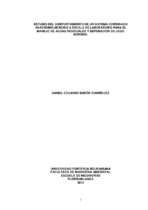| dc.contributor.advisor | Cajigas Cerón, Álvaro Andrés | |
| dc.contributor.author | Barón Rodríguez, Daniel Eduardo | |
| dc.coverage.temporal | 2013 | |
| dc.date.accessioned | 2020-08-28T14:59:20Z | |
| dc.date.available | 2020-08-28T14:59:20Z | |
| dc.date.issued | 2013 | |
| dc.identifier.uri | http://hdl.handle.net/20.500.11912/5871 | |
| dc.description | 74 páginas | spa |
| dc.description.abstract | El incremento continuo del caudal y la reducida capacidad de remoción del sistema secundario en la Universidad Pontificia Bolivariana - seccional Bucaramanga, hacen necesaria la búsqueda de alternativas para continuar cumpliendo con la normatividad actual, dentro de las soluciones aplicables por la institución, la opción de un sistema de tratamiento aerobio es una buena alternativa. En este estudio se evaluó la posibilidad de implementar un sistema aerobio para la depuración del agua residual como pulimiento del trabajo realizado por el reactor anaerobio. Adicionalmente se evaluó recomendaciones de estudios previos, donde se sugirió adicionar una fuente de carbono para mejorar la relación optima con el nitrógeno y el fosforo para afluente del reactor anaerobio. El sistema propuesto constó de un reactor UASB seguido de un reactor de lodos activados con mezcla completa. La recirculación de lodo aerobio en el reactor anaerobio permitió un mejoramiento en el desempeño del reactor anaerobio pasando de remociones del orden del 60 % al 80%. El sistema total logró remociones de sólidos, nitrógeno total y MO (Depuración: 91% de MO, 83,04% de sólidos y 46,63% de nitrógeno total). | spa |
| dc.description.abstract | The continuous increase of flow and reduced clearance capacity of the secondary system at the Universidad Pontificia Bolivariana - Bucaramanga, requires finding alternatives to remain in compliance with current regulations, applicable solutions within the institution, the choice of an aerobic treatment system is a good alternative. In this study we evaluated the chances of implementing an aerobic system for wastewater purification and polishing of the work done by the anaerobic reactor. Additionally, previous studies evaluated recommendations, which suggested adding a carbon source to enhance optimal relationship with the nitrogen and phosphorus to the anaerobic reactor effluent. The proposed system consister of a UASB reactor followed by an activated sludge with thorough mixing. The aerobic sludge recirculation in the anaerobic reactor allowed an improvement in the performance of the anaerobic reactor removals passing the order of 60% to 80%. The total system managed solids removal, total nitrogen and MO (clearance: 91% of MO, 83.04% solids and 46.63% of total nitrogen). | eng |
| dc.format.mimetype | application/pdf | |
| dc.language.iso | spa | |
| dc.publisher | Universidad Pontificia Bolivariana | spa |
| dc.rights | Attribution-NonCommercial-NoDerivatives 4.0 International | * |
| dc.rights.uri | http://creativecommons.org/licenses/by-nc-nd/4.0/ | * |
| dc.subject | Aguas residuales | spa |
| dc.subject | Aguas residuales - Purificación | spa |
| dc.subject | Laboratorios | spa |
| dc.title | Estudio del comportamiento de un sistema combinado anaerobio - aerobio a escala de Laboratorio para el manejo de aguas residuales y depuración de Lodo Aerobio | spa |
| dc.type | Práctica | spa |
| dc.publisher.department | Escuela de Ingenierías | spa |
| dc.publisher.program | Ingeniería Ambiental | spa |
| dc.type.hasVersion | publishedVersion | spa |
| dc.description.sectional | Bucaramanga | spa |
| dc.description.degreename | Ingeniero Ambiental | spa |


